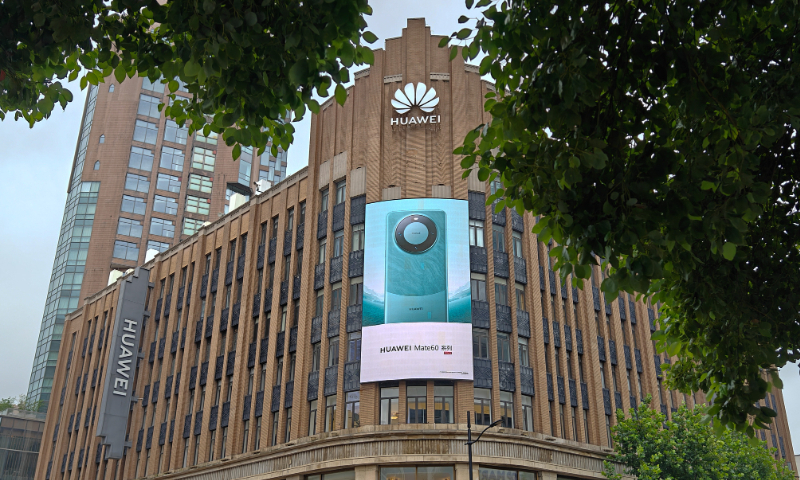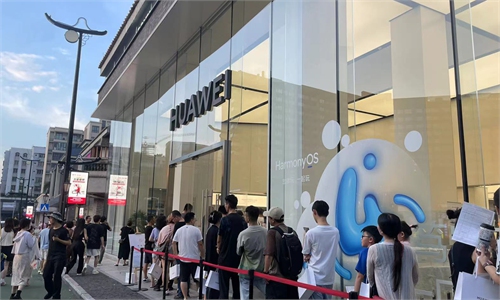Huawei Mate 60 Pro draws public closer to China’s space communication satellite system

The photo taken on August 30, 2023 shows the Huawei flagship store on Nanjing Road, Shanghai. Photo: VCG
Powered by China's state-of-the-art Tiantong-1 communications satellite system, Huawei's new flagship Mate 60 Pro has become world's first phone model with satellite calling feature, with observers hailing the development as helping tap into the full potential of China's space technology application for the mass consumer market.
Tiantong-1 system is the country's first self-developed mobile communications satellite system, and currently has three satellites operating in orbit. China Telecom is the sole operator of the Tiantong system's mobile services. China Telecom users of the 1740 number segment could access the satellite system for mobile communication services including video calls when without mobile signals, the Global Times has learned.
China launched the Tiantong-1 01 satellite on August 6, 2016, the Tiantong-1 02 on November 12, 2020 and the last, Tiantong-1 03 on January 20, 2021. The Tiantong-1 satellite system officially began providing satellite communications services to the public in January 2020.
According to the developers of the Tiantong-1 system from the China Academy of Space Technology, China has achieved the full mobile communication services coverage over the Asia-Pacific region as the Tiantong-1 03 joined force with the Tiantong-1 01 and 02 satellites, providing voice calling, short messaging service (SMS), data and video transmission services for users in the region.
Tech giant Huawei last year introduced the Mate 50 series with the first generation of satellite SMS technology, which allows only one-way SMS connectivity. For the Huawei P60 Series, Huawei upgraded this tech for two-way SMS conversation.
The satellite system now has no restrictions on signal coverage. This makes the Huawei new model seamlessly connected in mountain, ocean, plateau, forest, and other geographies, Huawei said in a press release addressing the new satellite calling feature.
Xiang Ligang, director-general of the Beijing-based Information Consumption Alliance, told the Global Times on Wednesday that compared with traditional satellite communication terminals, it cost only half that price for users to access the satellite calling service using a Huawei Mate 60 Pro.
"The easier and cheaper access to the satellite services would increase the market need of satellite communication, creating more income in the industry and in return stimulating growth of number of such satellites and advancement of such technology, Xiang noted.
Space observers also noted that just like the Chinese mega space infrastructure BeiDou Navigation Satellite System or the BDS, China's Tiantong-1 mobile communication satellites would become more and more familiar and useful to the general public with more accessible terminals enabling such services. The Chinese public would also have better understanding of the country's robust growth in space exploration.
Tiantong-1 mobile communication satellite system has been making an important contribution across emergency communication, disaster rescue and relief. For example, when the Long March-11 rocket carried out launch at sea where there were no mobile signals and broad-band internet service, Tiantong-1 could transmit the video of the launch event right away.
Huawei officially kicked off online sales for its latest flagship Mate 60 Pro on Sunday, marking a major step for the high-end smartphone to hit the mass domestic market as public expectations and demand for the device remain high. And more importantly, the roll-out of the Mate 60 Pro with China's self-developed Kirin mobile chipset offers proof that China's homegrown semiconductor industry is advancing despite the US ban.


